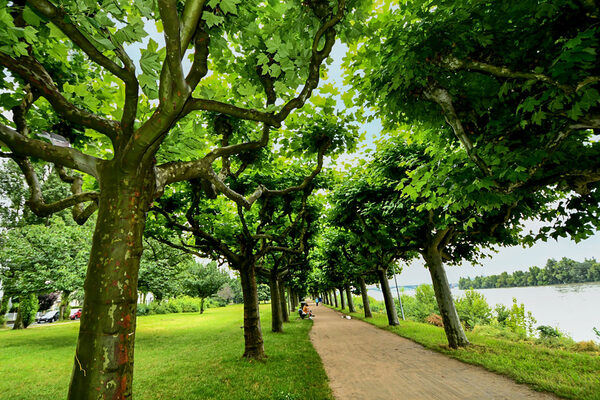Of dyers and raftsmen: Kastel in transition
Kastel is the only municipality in Hesse that still bears its Roman founding name today.
Foundation
Kastel is the only municipality in Hesse that still bears its Roman founding name today. Around the twelfth to ninth century BC, the Roman general Drusus built the Castellum Mattiacorum, a military camp to protect the Mainz legionary camp. A short time later, the first bridge was built over the Rhine, connecting the settlement of Mogontiacum (now Mainz) with Kastel. In the first century, the camp was additionally secured with a stone wall.
Evidence of Roman presence
The Roman bridge led to today's Große Kirchenstraße on the right bank of the Rhine and led directly into the castle, whose second gate was only a few meters from the foundations of the Roman Arch of Honour, which were discovered in 1986. Around 287, Emperor Maximinian had a stone bridge built, the construction of which is documented on a lead cast near Lyon. During the Roman era, which lasted almost 400 years, numerous buildings were constructed, including a bathhouse. The martyr Ferrutius died in Castell before the Franks took over.
In the Middle Ages
Under Charlemagne, a new bridge over the Rhine was built between 803 and 813, but it burned down shortly after its completion. In the 13th century, Kastel became an "imperial city" and experienced a period of prosperity. The heyday of the dyers (rowing boats for people and freight) and raftsmen began in the early 14th century. Constant raids prompted Archbishop Berthold von Henneberg to build the Erbenheimer Warte at Fort Biehler in 1497. The Bartholomew Market was founded as early as 1475 and still exists today.
Destruction and reconstruction
Kastel was ravaged by war several times. During the Thirty Years' War, the plague was rampant and half the population fell victim to it. Parts of this 17th century wall have been preserved to this day and are a reminder of how Kastel overcame major crises.
In 1689, French troops burned the town to the ground. During Napoleon's campaign in 1812, the Kastel dyers managed to cross the Rhine safely despite the ice. In 1816, Kastel and Mainz were declared a federal fortress.
Jewish community
The Jewish community of Kastel, whose history dates back to the 15th century, helped shape the social and cultural life of the town. In 1833/34, a synagogue with a community center was built in Frühlingsstraße. After the community was dissolved in 1914, its members were incorporated into the Mainz community. Jewish citizens continued to live in Kastel afterwards. Many of them were murdered during the Holocaust.
Progress and freedom
Kastel underwent a transformation in the 19th century. The second German railroad line between Wiesbaden and Kastel was opened in 1840. Liberal ideas prevailed: The Kastel Choral Society was founded in 1844, and the Social Democratic Workers' Party was founded here in 1874.
From destruction to new life
Following its incorporation into Mainz in 1908 and the devastation of the Second World War, in particular the bombing in 1944, Kastel was separated from Mainz in 1945 and placed under the control of Wiesbaden. Reconstruction was carried out by committed citizens who created a democratic future for Kastel.
Kastel today: Proud of its past and present
Today, Kastel is a modern district that retains its historical roots. The "Kasselers" are proud of the local history museum in the Reduit, the history fountain and the excavations of the Roman walls. Kastel is also a stronghold of the carnival and offers ideal access for visitors thanks to its good transport links - by train, car and boat.
Reconstruction and growth
After the war, the population grew from 1,092 to 1,477 in 1950 due to the influx of displaced persons. Infrastructure projects were carried out in the following years: the demolition of the old town hall in 1957, the extension of the school in 1954 and the development of new building areas, initially on the outskirts of the village, later also in the village center. In 1984, the local council started the redevelopment of the historic town center, which was listed as a historical monument in 1988 and renovated in the 1990s.
Close to Wiesbaden
Today, the Igstadt district is farmed by a small number of full-time farmers. In 2009, there were 177 commercial enterprises, mainly small businesses. Most of the inhabitants work in Wiesbaden and the Rhine-Main region.
Historical highlight
Winter 1886: Kastel residents walk across the frozen Rhine to Mainz in 22-degree temperatures.
